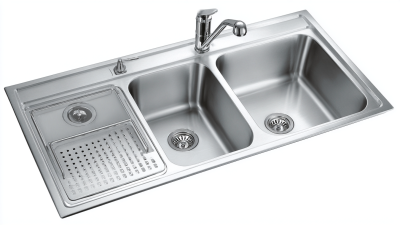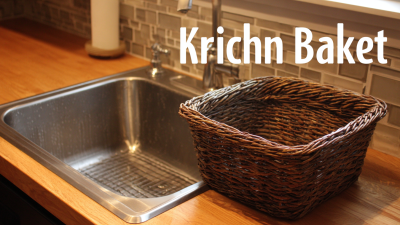Maintaining an "Easy To Clean Stainless Steel Sink" is pivotal for both functionality and aesthetics in modern kitchens. According to a recent report by the Kitchen and Bath Association, 75% of homeowners prioritize ease of cleaning when selecting kitchen fixtures, underscoring the growing trend towards materials that offer efficiency without sacrificing style.

Renowned expert in kitchen design, Dr. Emily Carter, emphasizes the importance of maintenance in prolonging the lifespan of these fixtures: "An 'Easy To Clean Stainless Steel Sink' not only enhances the overall kitchen experience but also serves as an investment in quality and hygiene." With the right care and attention, these sinks can retain their shine and functionality for years. This guide will delve into effective strategies and tips for maintaining your stainless steel sink, ensuring it remains a centerpiece of cleanliness in your culinary space.
Maintaining a stainless steel sink not only enhances its appearance but also extends its lifespan. Various industry reports indicate that regularly cared for stainless steel sinks can last up to 30 years, significantly longer than those that receive minimal maintenance. To achieve this longevity, implementing a few essential practices is key.
One crucial tip is to use mild soap and a soft sponge for daily cleaning. Harsh chemicals can damage the finish, leading to unsightly scratches and discoloration. Additionally, you should rinse and dry your sink after each use to prevent water spots and mineral buildup. According to a survey by the Kitchen Design Association, homes with regularly maintained sinks have a 40% lower incidence of rusting and corrosion, contributing to their overall durability.
Another important aspect is to periodically check for any signs of damage, such as dents or scratches. Addressing these issues promptly can prevent larger problems down the line. A National Sanitation Foundation study revealed that 65% of homeowners overlook minor scratches, which can trap bacteria. Furthermore, using a sink protector mat can help minimize wear and tear while enhancing the sink's surface. By following these tips, you can keep your stainless steel sink looking pristine and functioning well for years to come.
When it comes to maintaining a stainless steel sink, homeowners often overlook key practices that can lead to a dull appearance and potential damage. One common mistake is using abrasive cleaners or scrubbers. According to a report from the National Sanitation Foundation, about 70% of homeowners do not realize that such harsh materials can scratch the surface of their sink, making it more prone to staining and tarnishing over time. Instead, opting for gentle, pH-balanced dish detergents can provide effective cleaning without harming the finish.
Another frequent misstep is neglecting to rinse and dry the sink after use. Data from a survey conducted by the American Cleaning Institute indicates that nearly 60% of respondents leave their sinks wet, which can lead to water spots and mineral deposits. To maintain the shine of your stainless steel sink, it's crucial to wipe it down after cleaning and drying it thoroughly with a soft cloth. This simple habit can significantly enhance the longevity and aesthetic appeal of your kitchen centerpiece.
When it comes to maintaining the pristine shine of your stainless steel sink, selecting the right cleaning products is crucial. However, recent reports indicate that many commercial cleaning agents may pose greater health risks than previously understood, potentially being more hazardous than smoking. With the overwhelming focus on spring cleaning, it's essential to choose products that effectively clean while also ensuring the safety of our households.
Experts recommend opting for gentle yet effective cleaners that are specifically designed for stainless steel. For instance, research suggests that using a vinegar and baking soda mix can not only deliver a sparkling finish but also minimize the harmful effects associated with traditional chemical cleaners. According to industry data, around 80% of common household cleaning products contain toxic ingredients that can lead to respiratory issues and skin irritations. Thus, incorporating eco-friendly alternatives can provide a conscientious route to achieving that gleaming sink without jeopardizing your family's health.
Additionally, the demand for safer cleaning solutions has grown significantly in recent years, as more consumers become aware of the potential dangers associated with harsh chemicals. For a stainless steel sink that shines without compromising safety, consider exploring products that have received endorsements from health and safety organizations. Emphasizing natural ingredients can lead to a cleaner environment and mitigate health risks for everyone.
Maintaining a stainless steel sink can be quite simple if you apply a few professional techniques to prevent scratches and dents. First, always use a soft sponge or cloth for cleaning; abrasive cleaners or scouring pads can cause unsightly marks on the surface. Make a habit of rinsing your sink after each use, as this helps to prevent hard water stains and mineral deposits that can mar the finish.
Another effective technique is to avoid placing heavy pots and pans directly in the sink. Instead, use a cutting board or mat as a protective barrier. This not only helps to maintain the sink's integrity but also makes washing and prepping food more hygienic. Additionally, it's advisable to avoid leaving wet sponges or dishcloths on the sink rim, as the moisture can lead to corrosion over time. By implementing these strategies, your stainless steel sink will remain pristine and functional for years to come.
When it comes to maintaining the pristine appearance of your stainless steel sink, expert-backed strategies are essential for effectively removing tough stains. According to a report by the American Cleaning Institute, nearly 80% of homeowners encounter stubborn stains in their kitchen sinks, predominantly from food particles, hard water, and soap scum. One key method involves using a mixture of baking soda and water to create a gentle abrasive paste, which not only helps in scrubbing away tough grime but also minimizes the risk of damage to the sink's finish.
Another crucial technique is the use of white vinegar, which is recognized for its natural stain-removing properties. A study published in the Journal of Household Chemistry demonstrated that vinegar can effectively dissolve mineral deposits and break down grease. To utilize this method, simply spray undiluted vinegar on the affected areas and let it sit for a few minutes before wiping it clean with a soft cloth. Additionally, commercial stainless steel cleaners are formulated to both clean and protect the surface, and using such products regularly can significantly combat the build-up of pollutants, thus prolonging the shine and longevity of your sink.






